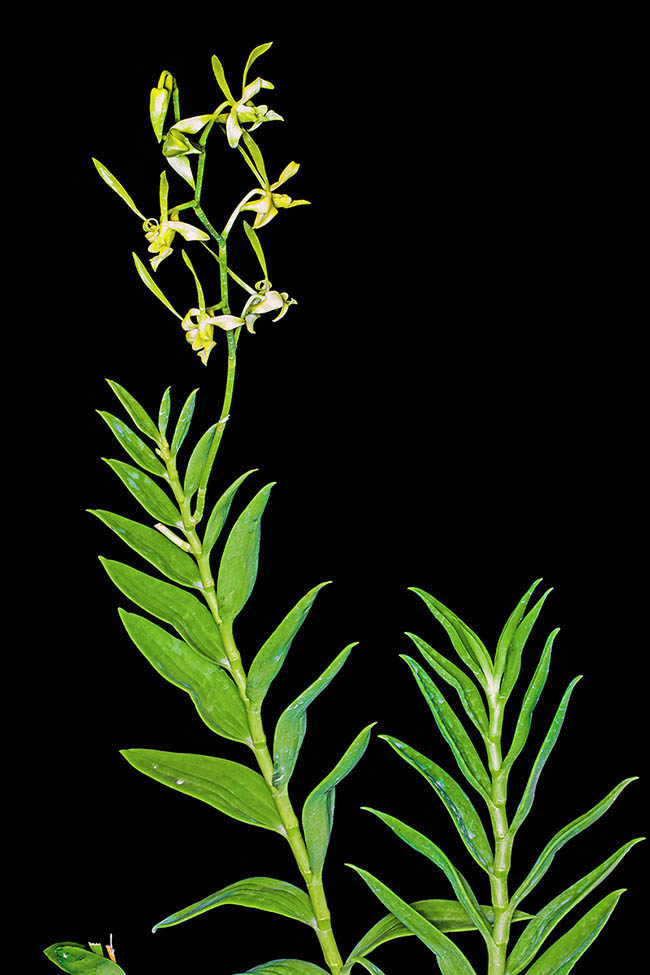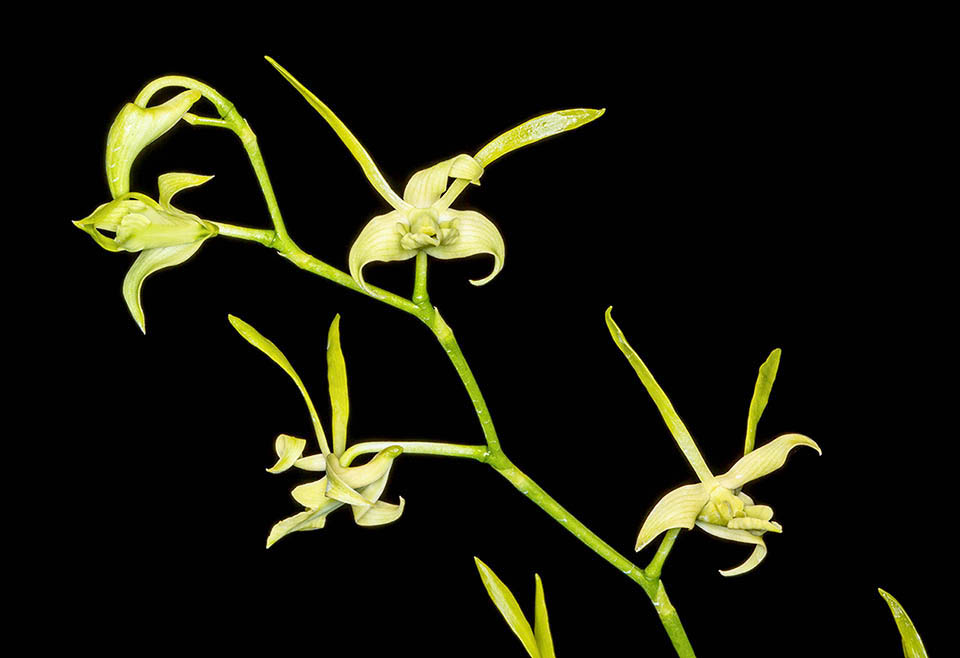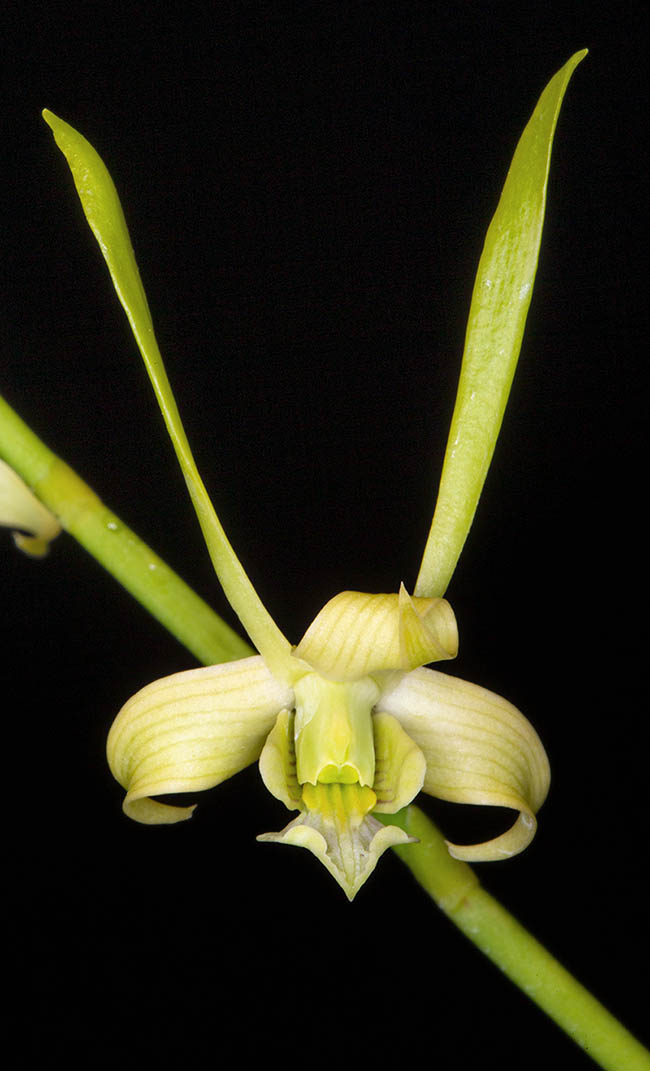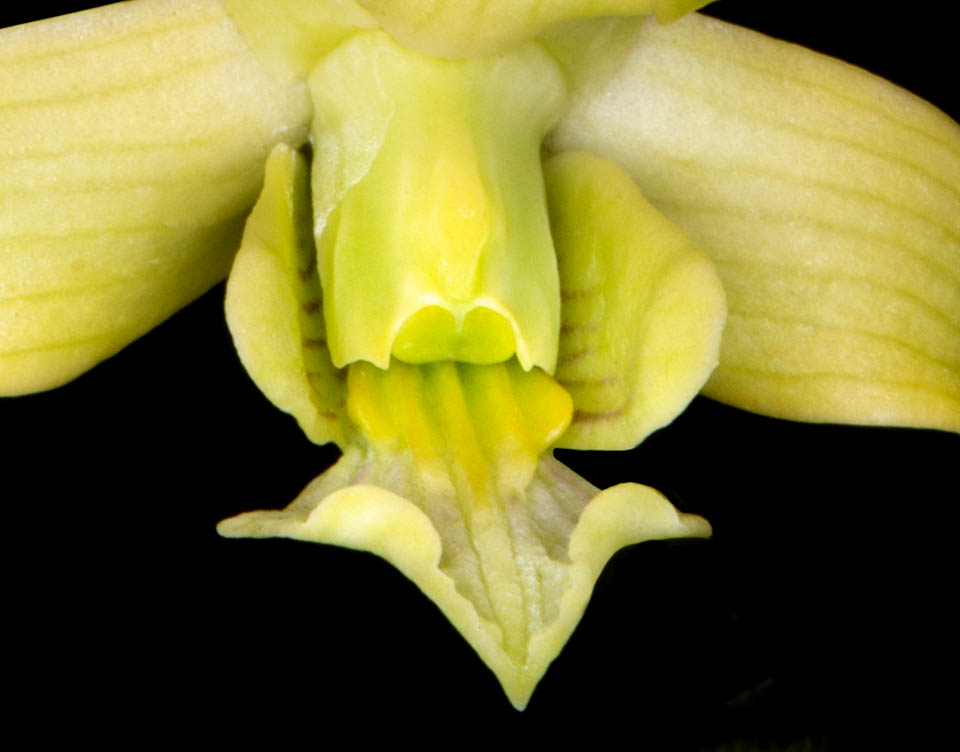Family : Orchidaceae

Text © Prof. Pietro Pavone

English translation by Mario Beltramini

Dendrobium archipelagense is an epiphytic orchid described only in 2002, endemic to Bismarck archipelago © Giuseppe Mazza
Dendrobium archipelagense Howcroft & W.N.Takeuchi (2002) is a species of the family Orchidaceae, subfamily Epidendroideae, tribe Malaxideae, subtribe Dendrobiinae, endemic to the Bismarck Archipelago off Papua New Guinea. It lives on the coastal trees of the plain rainforest up to about 250 m of altitude.
Dendrobium archipelagense is a new species described in 2002 by Neville Henry Simco Howcroft (1938-) and Wayne N. Takeuchi in the publication SIDA, Contributions to botany vol. 20: 464- 466 2002.
Previously, this species was included in Dendrobium strepsiceros J.J. Sm. (1912) after a careful analysis, have been seen differences in the shape and the extension of the labellum, in the median and lateral lobes and in the median crest of the callus, consequently it has been considered as a species itself. Moreover, for these characteristics of the labellum, Dendrobium archipelagense is more similar to Dendrobium antennatum Lindl. (1843) and not to Dendrobium strepsiceros.
The name of the genus is the combination of the Greek substantives “δένδρον” (dendron), tree and “βίος” (bios), life, due to the numerous species of the genus living on the trees getting nourishment from the humid atmosphere typical to the equatorial forests.
The specific name refers to the place where it has been found, that is the Bismarck Archipelago.
In English, it is commonly called : The Archipelago Dendrobium.
The genus Dendrobium is one of the largest of the family Orchidaceae. It counts 1500-2200 species, vulgarly called bamboo orchids, present in quite different habitats, with a very ample range. In fact, they are distributed form tropical and subtropical Asia to Oceania, including India, Sri Lanka, Himalaya, Myanmar, Thailand, China, Japan, Malaysia, Indonesia, Australia, New Guinea and the Pacific islands.
Usually they are epiphytic plants, and as such are limited to areas with moderate to heavy precipitations such as the tropical plains up to higher altitudes at the tropics or in cooler zones with high annual rainfalls and a dry season not exceeding the 6 months. They live on the branches of the trees just over the limit of the wood. They are present in the swamp forests whilst in the temperate regions they are able to tolerate drier conditions. They are absent in the arid woods, in the deserts and semi-deserts, in the cold alpine environments.
The species of Dendrobium vary in size; from small plants like Dendrobium moniliforme (L.) Sw. to several metres tall plants such as Dendrobium discolor Lindl.
About 40 species of Dendrobium are commonly utilized in traditional Chinese medicine and some of them, like Dendrobium catenatum Lindl., are disappearing due to the excessive exploitation. Also the excessive harvesting of ornamental species and the destruction of the habitats, due to fires and to deforestation, are the cause of extinction of many species of this genus.

Has short rhizomes and even 50 cm long pseudobulbs. They have one or more erect inflorescences with an about 40 cm rachis and 5-10 flowers per raceme © G. Mazza
Recently they have created techniques for improving the germinative capacity of the seeds of the plant at risk of extinction. The asymbiotic germination in vitro of immature seeds is one of these and is utilized for accelerating and increasing the efficiency of the germination keeping the genetic variability inherent în the seeds. For the plants of commercial utilization, rather than the seeds propagation, recourse is done to the micropropagation utilizing the apex of the shoot or the cultivation of axillary buds.
The genus Dendrobium following the description of various species included in it, has been created by the Swedish botanist and taxonomist Olof Peter Swartz (1760-1816) in the publication Nova Acta Regiae Societatis Scientiarum Upsaliensis. Uppsala ser. 2, 6: 82 (1799). This genus is characterized by inflorescences forming in the upper part of the shoot, from lateral sepals that form a structure, called mentum, with the foot of the column and four pollen masses. An evolutionary particularity, unique and exclusive to this genus, is that the rostellum is hollow and swollen and when just touched releases an opaque liquid similar to a glue for improving the adhesion of the pollen grains to the stigma.
The taxonomy of the genus Dendrobium is fairly complex due to the morphological diversity, the ample range of distribution, the great number of species and the morphological differences within the same species due also to convergence phenomena.

The wide opening flowers, of pale green colour turning yellow-green with age, measure 4,0-5,5 x 3,5 cm © G. Mazza
Indeed it is well known that many species of Dendrobium are morphologically similar and their identification is based on particular morphological characters visible only during the flowering. With the results of the molecular analyses it has been possible to improve the taxonomy, even if there are still uncertainties and the debate among the. specialists is still existing;
In 2025, Chase and collaborators have suggested a new classification of the family Orchidaceae (An updated classification of Orchidaceae. – Botanical Journal of Linnean Society 177: 151-174 2015) that takes into account the data of literature recently published.
Dendrobium archipelagense is an epiphytic plant with short rhizomes and 50 x 1-2 cm sub cylindrical pseudobulbs swollen at the base, thinner at the apex, with persistent nodal sheaths shorter than the internodes. The leaves are distichous, lanceolate-ovate, coriaceous, 7,5-9,5 x 2,0-3,0 cm; slightly concave in the upepr pagina with entire margin and slightly indented apex (emarginate).
Usually their colour varies from green to yellow-green depending on the exposition to the light. The inflorescences, one or more per pseudobulb, are racemose, erect, normally inserted at the apex, with an about 9 cm long peduncle and with axis (rachis) of about 40 x 0,2-0,3 cm. The flowers, with wide (4,0-5,5 x 3,5 cm) opening, are 5-10 per raceme, of pale green colour turning yellow-green with age.
In the places of origin they start to appear during the month of January. The median sepal is curved, twisted one turn, oblong-lanceolate (2-2,6 x 0,6-0,7 cm), with acuminate apex. The lateral sepals are curved, oblong-lanceolate (2,5-3,3 x 0,9 cm), adnate to the foot of the column and to part of the lip to form a particular 01-3 cm spur, called mentum. The petals are twisted one or two turns, enlarged, linear, of 3-4,5 x 0,25-0,4 cm, with acute apex. The labellum, of colour similar to the sepals and the petals but with reddish veins, is straight, trilobate, (2-2,3 x 1-1,5 cm) with oblong-elliptic lateral lobes (1,15 x 1,5 cm). The callus has 5 keels slightly edged in violet, those lateral do not extend beyond the base of the median lobe but the median one extends up to the apex. The ovary is glabrous, 0,9 cm long and the column is of 0,5 cm with laterally bilobate apex.
The perianth persists on the fruit. Simultaneously with the production of the new flowers, are released the seeds from the fruits formed during the previous year.
Dendrobium archipelagense is a species inscribed in the Appendix II of Washington Convention (CITES) that has the purpose of protecting the animal and vegetable species under risk of extinction, forbidding their export and detention. It is also inserted in the red list of the International Union for the Conservation of Nature (IUCN) in the category of “minimal risk” (LC, Least concern).
In cultivation the plant requires warm temperatures, good luminosity, high atmospheric humidity in the measure of 60-80% and proper ventilation. Any substratum will do, the important thing is that it must be very draining. The waterings, with rain water, by reverse osmosis or demineralized, must be abundant during the growth season whilst in winter they must be reduced till when the new buds do appear. Fertilizations are to be done during the vegetative period preferably with specific products for the orchids, balanced, hydrosoluble and with microelements, in the measure of 1/2 – 1/4 of the dose recommended on the package.

Enlarged detail of the typical labellum. Has a colour similar to the sepals and petals but with reddish veins. It looks straight, trilobate, with oblong-elliptic lateral lobes. The callus displays five slightly raised keels. The lateral ones don’t extend beyond the base of the median lobe but the median keel reaches the apex © Giuseppe Mazza
Like many Dendrobium, this species should be repotted when necessary and only in spring. It can be reproduced by seed, by micropropagation and by division of the tufts at the time of the vegetative regrowth with at least 3-4 pseudobulbs united together.
Hybrids and cultivars of Dendrobium archipelagense do exist.
The hybrid Dendrobium Yam Ah Mee, registered at the Royal Horticultural Society by Gardens By The Bay in 2013, is originated by cross of Dendrobium Tandi × Dendrobium archipelagense.
Dendrobium Anna Maria, registered by E. P. Hendra on Febr. 14, 2020 at the Royal Horticultural Society, has been obtained by cross of Dendrobium Black Spider × Dendrobium archipelagense.
Among the recently awarded cultivars we mention: Dendrobium archipelagense ‘Irene’, Dendrobium archipelagense ‘Grasshopper’ and Dendrobium archipelagense ‘Ginny’.
